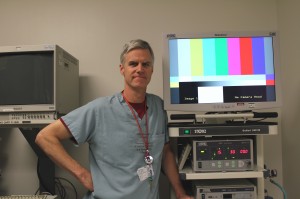There’s an art to surgery, and while surgeons orchestrate and perform, technicians in the operating room also make important contributions. California State University, Dominguez Hills alumnus Andrew J. Leist is one such technician, bringing his digital media arts skills to the medical field.

After receiving his bachelor’s degree in digital media arts in 2008 and while continuing to work in the music industry, Leist landed a job as an audio/visual technician at USC University Hospital Department of Surgery in Los Angeles, where he manages media technology used by surgeons performing endoscopic procedures.
“It’s fascinating. Before I started [working at USC University Hospital], I didn’t realize how many endoscopic or laparoscopic cases there are,” said the full-time media specialist.
According to MedlinePlus.com, there are several types of endoscopic procedures including laparoscopy, which looks into the abdomen or pelvis. All of the minimally invasive endoscopic procedures use tiny cameras (scopes) at the end of long tubes, which are inserted into the body through keyhole incisions in the skin.
“In the past they’d have to cut you open. But with these new procedures, videos allow the surgeons to go into the body through three small one-inch incisions. One incision for a scalpel, one for another tool–like forceps, and one for the camera,” said Leist. “Using video cameras via small incisions, there’s less damage to tissues and patients recovery more quickly.”
The cameras help surgeons as they navigate tissues, organs, and bones inside the body.
“What the surgeon sees with video cameras looks better than what they can see with only their eyes. The cameras produce high-definition, full-color images. They can zoom in and magnify views, and they can get to areas that are difficult to see just by looking into traditional incisions,” said Leist.
Prior to the surgeons’ arrival in the operating room, Leist selects, arranges, and prepares audio/visual equipment based on several criteria.
“The size of the microscope is dictated by the procedure. For instance, for brain cases, which are very small procedures, smaller microscopes are used. How I set up the angle of the lens depends on what view a surgeon wants to see. Where I put the equipment depends on where the doctors, nurses and other technicians will be. Video is mostly used, however some surgeons do request audio, mainly to record their notes during surgery,” said Leist.
Previous work as an information technology manager at Cedars-Sinai Medical Center helped Leist to feel comfortable working in a hospital setting. Once at USC University Hospital he received training for working in a surgical environment, including cleaning and sterilizing equipment to help prevent infection, and working with a medical team in the operating room. But for the technical aspects of his job, he arrived prepared with the education he received at CSU Dominguez Hills.
“Training at CSUDH was helpful in me getting this job. I was looking for a job during tough times. The competition was fierce,” said Leist. “It’s smart to be open-minded to other kinds of careers that you might not think of right away. There are cutting-edge media types of jobs that aren’t at movie studios producing entertainment.”
During his free time, Leist works as a musician and audio engineer. He has recently written original music for “Daughter,” a play by Bradley Rand Smith. His digital media arts specialties include audio recording, editing, and mixing; writing and arranging music; audio and video encoding; and production and management. More information about his musical endeavors can be found on his website, www.agilemusic.com.
For more information about the Digital Media Arts program, contact the department office at (310) 243-3543 or click here.
–Photo courtesy of Andrew Leist